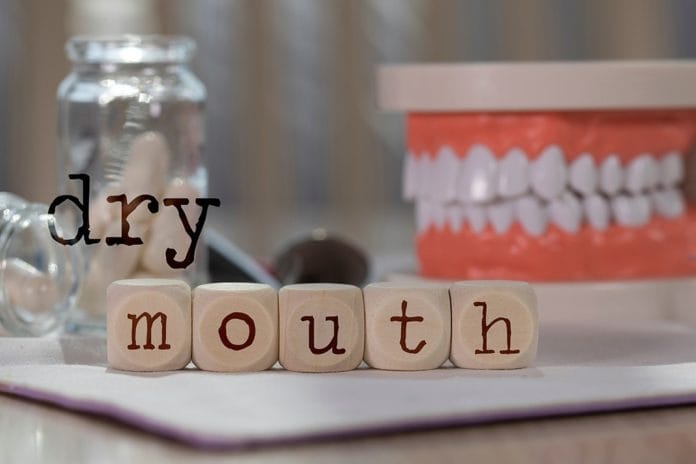Xerostomia can be described as a “subjective sensation of oral dryness”1 with numerous causes. The most common are as a side effect from certain medications, Sjogren’s syndrome and other autoimmune disorders, and radiation therapy.1
Older patients are generally taking more medications, and so we tend to see xerostomia in this population more frequently than any other. However, anyone taking medications can be at risk for developing it. This widespread risk is one of the many reasons a thorough health and medical history is imperative for all of our patients.
Patient Signs and Symptoms
Patients with xerostomia will often complain of a decrease in taste sensation, as well as difficulty swallowing, chewing, and even speaking. Signs that may present themselves clinically are a decrease in the color of the gingiva and surrounding tissues, the mucosa may appear fragile, the tongue may be fissured, and the lips may be dry.2
The “lipstick test,” which is finding lipstick dried on a patients’ front teeth, can be an obvious sign of xerostomia.3 You may also notice while treating a patient that your mouth mirror sticks to the buccal mucosa. I have personally seen numerous patients who didn’t mention any concerns about xerostomia to me, but when I point out that my mirror sticks, they tell me they have been experiencing many symptoms of xerostomia, and they just didn’t realize it.
Xerostomia and Periodontal Disease
With a lack of adequate saliva, we see an increase in caries and periodontal disease in our patients. Along with helping us speak, digest our food, and keep our mouth lubricated, saliva cleanses the oral cavity from harmful bacteria that includes periodontal pathogens.3
There is a direct cause-and-effect relationship between the lack of saliva and an increase in oral bacteria. As one study found, “Xerostomia was related to dental plaque formation.”4 Hygienists know and understand the role that dental plaque plays in periodontal disease. If not effectively removed, the plaque leads to gingivitis, which, if left untreated, can lead to periodontitis.
The saliva also helps keep the tissues in the oral mucosa healthy and intact by keeping it moist and hydrated. Without it, the tissues can be susceptible to damage such as ulcers, abrasions/cuts, and occasionally tearing of the outermost layer of epithelium.3
Oral Hygiene Concerns
Since xerostomia can cause discomfort for patients, they may be unable to maintain good oral hygiene. As we know, good oral hygiene is imperative for all patients, but even more so, those who may be predisposed to periodontal disease for whatever reason.
Oral hygiene is something these patients can control, which may help encourage patients to work diligently at it. It is our job to help encourage these patients and think outside of the box when it comes to our home-care recommendations. One of the most difficult challenges to recommending products for these patients is coming up with items they can use when they are in an acute state of pain due to their xerostomia. When these patients are experiencing this pain, it often is difficult for them to use any of the traditional hygiene products we recommend on a daily basis. A couple of adjunct products for these patients could be baby toothbrushes and oral sponges.
Tools and products that may further irritate or damage the tissues when the patient is experiencing a painful episode should be avoided. For example, electric toothbrushes and powered flossers may be too aggressive for a patient experiencing pain due to their xerostomia.
It is important for us as clinicians to recommend products that will not further dry out the mouth or cause discomfort. Alcohol-free mouth rinses and very mild kinds of toothpaste with little to no flavoring are all good places to start.2 Be aware that some xerostomia products have an acidic pH, which may do the patient more harm than good.
Clinical Considerations for Patients with Xerostomia
Clinicians should try to avoid or limit products that could irritate the tissues further.2 I personally would avoid both mint-flavored prophy paste and fluoride treatments when treating these patients as they can cause a burning sensation. You may find these patients need more frequent breaks during recall appointments because having their mouth open for a long period of time exacerbates their condition.
Considering more frequent recalls for these patients may be indicated. This way, if periodontal disease does appear, it can quickly be treated. Periodontal probing at each visit and more frequent radiographs may also be indicated to closely monitor for disease activity.
At-Home Recommendations
Recommending these patients stay hydrated is crucial to their overall dental health; encourage these patients to drink water and sugar-less beverages frequently. Patients should understand the importance of limiting food and beverage choices that further decrease saliva production, such as caffeine, alcohol, and spicy/salty foods. They should also familiarize themselves with choices that may help to temporarily boost saliva flow. Some examples are sugar-free chewing gum and hard candies, as well as citrus-flavored lozenges. Many sugar-free gums nowadays contain xylitol, which hygienists know can help reduce the risk of caries.5 Clinicians may want to advise patients to avoid strong mint or cinnamon flavored sugar-free gums and opt for flavors such as bubblegum or citrus. Be sure the patient is free of any TMJ disorders before recommending any chewing gums.
One study found a correlation between xerostomia and sugar-sweetened beverages, and that patients with severe xerostomia tended to eat less whole grains and consume more fruits.6 Nutritional counseling may be a great tool for these patients if they are struggling to find food choices that fit into their dietary needs while learning to live with xerostomia.
Conclusion
Although plenty of over-the-counter treatments claim to relieve dry mouth, one Cochrane Review stated that there is no clear evidence that any of these products work.7 This is why treating patients with xerostomia can be so difficult and frustrating. There is no cure or one-size-fits-all product or approach for them. Customize your clinical care and at-home recommendations, along with balancing patient preferences. We can help reduce their risk of developing periodontal disease caused by xerostomia while also keeping them as comfortable as possible.
Now Listen to the Today’s RDH Dental Hygiene Podcast Below:
References
- Tanasiewicz, M., Hildebrandt, T., Obersztyn, I. Xerostomia of Various Etiologies: A Review of the Literature. Adv Clin Exp Med. 2016 Jan-Feb; 25(1): 199-206.
- Oral Health Topics: Xerostomia. American Dental Association. Retrieved from https://www.ada.org/en/member-center/oral-health-topics/xerostomia
- Xerostomia. Oral Cancer Foundation. Retrieved from https://oralcancerfoundation.org/complications/xerostomia/
- Mizutani, S., Ekuni, D., Tomofuji, T., et al. Relationship Between Xerostomia and Gingival Condition in Young Adults. J Periodontal Res. 2015; 50(1): 74-9. Retrieved from https://pubmed.ncbi.nlm.nih.gov/24697562/
- National Institute of Dental and Craniofacial Research. Dry Mouth. July 2018.
- Quandt, S.A, Savoca, M.R, Leng, X., et al. Dry Mouth and Dietary Quality Among Older Adults in North Carolina. J Am Geriatr Soc. 2011 Mar; 59(3): 439–445. Retrieved from https://www.ncbi.nlm.nih.gov/pmc/articles/PMC3096847/
- Furness, S., Worthington, H.V., Bryan, G. Birchenough, S., McMillan R. Interventions for the Management of Dry Mouth: Topical Therapies. Cochrane Database of Systematic Reviews. 2011; 12. Retrieved from https://www.cochranelibrary.com/cdsr/doi/10.1002/14651858.CD008934.pub2/abstract











